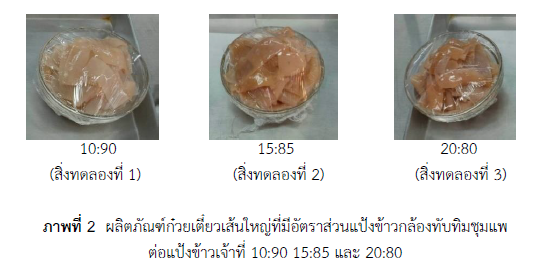An Application of Tubtim Chumphae Brown Rice Flour for Big Flat Noodle’s Product
Main Article Content
Abstract
The objective of this study is to apply Tubtim Chumphae brown rice flour as a substitute for rice flour in the production of big flat noodles to gain consumer acceptance. The study explored standard formulations and examined the ratio of Tubtim Chumphae brown rice flour to rice flour at three levels: 10:90, 15:85, and 20:80. The experiment followed a randomized complete block design (RCBD) and assessed sensory quality using a 9-point hedonic scale. The panelists gave the highest liking score for the aroma of noodle formula 1 after selecting the standard recipe. The study of the appropriate ratio of Tubtim Chumphae brown rice flour to rice flour in big flat rice noodle production revealed that increasing the amount of Tubtim Chumphae brown rice flour reduced the texture preference scores, while the color, aroma, and overall preference scores increased. Additionally, noodles with a 15:85 ratio of Tubtim Chumpae brown rice flour to rice flour received the highest scores for color, aroma, texture, and overall preference. Consumers accepted and were willing to purchase the big flat noodles made from Tubtim Chumpae brown rice flour at 99.00% and 100.00%, respectively.
Article Details
References
กนกอร พวงระย้า. (2560). การพัฒนาผลิตภัณฑ์เส้นก๋วยเตี๋ยวจากแป้งลูกเดือยทดแทนแป้งข้าวเจ้าบางส่วน. [วิทยานิพนธ์มหาบัณฑิต]. มหาวิทยาลัยเทคโนโลยีราชมงคลพระนคร.
ถาวร จันทโชติ. (2556). การพัฒนาผลิตภัณฑ์ก๋วยเตี๋ยวจากแป้งข้าวกล้องงอกจากข้าวสังข์หยดเสริมไข่ขาว (รายงานวิจัยฉบับสมบูรณ์). สำนักบริหารโครงการวิจัยในอุดมศึกษาและพัฒนามหาวิทยาลัยวิจัยแห่งชาติ มหาวิทยาลัยทักษิณ.
ไพโรจน์ วิริยจารี. (2561). การประเมินทางประสาทสัมผัส (พิมพ์ครั้งที่ 2).มหาวิทยาลัยเชียงใหม่.
โยธิน ปัญญาแก้ว. (2563, 3 เมษายน) สูตรก๋วยเตี๋ยว. Wongnai. https://www.wongnai.com/recipes/ugc/82c99e78767949e78f132f3300164d93
รณชัย ช่างศรี, สุพัฒนา บุรีรัตน์, ธัญวราภรณ์ ปรุงฆ้อง, อโณทัย เพ็งเรือง, อำนวย พงษ์พนัส, ธนพัฒน์ รุ่งวัฒนพงษ์, สุกัญญา พันธุจิต, คมสัน น้อยนพพระ, พรวีนัส อรรควงษ์, ดาวประกาย คำแก้ว, พนัดดา น้อยนพพระ, อาภาสินี คำภูเขียว, สำเร็จ สุนทรา, สุขวิทยา ภาโสภะ, ชนะ ศรีสมภาร, ปัญญา คำแสนพันธ์, อลงกต ลีนารถ, เอกสิทธิ์ สกุลคู, อรสา วงษ์เกษม และพัชราภรณ์ รักชุม. (2559). ข้าวเจ้าพันธุ์ กข69 (ทับทิมชุมแพ). วารสารวิชาการข้าว, 7(2), 30-46.
ลลิตา ออมสิน, รณฤทธิ์ ฤทธิรณ และศุทธหทัย โภชนากรณ์. (2565). การพัฒนาผลิตภัณฑ์เส้นก๋วยเตี๋ยวจากข้าวพันธุ์เหลืองปะทิวชุมพร. วารสารวิทยาศาสตร์และเทคโนโลยี, 11(1), 30-38.
วริศชนม์ นิลนนท์, กุลพร พุทธมี, จิรพร สวัสดิการ และสุพร สังข์สุวรรณ. (2560, 19-20 ธันวาคม). การพัฒนาผลิตภัณฑ์เส้นก๋วยเตี๋ยวจากแป้งเมล็ดทุเรียน [เอกสารนำเสนอ]. การประชุมวิชาการระดับชาติวิจัยรำไพพรรณี ครั้งที่ 11 และงานประชุมวิชาการ มหาวิทยาลัยราชภัฏกลุ่มศรีอยุธยา ครั้งที่ 8, จันทบุรี.
วิจัยกรุงศรี. (2565). แนวโน้มธุรกิจ/อุตสาหกรรม 2565-2567: อุตสาหกรรมข้าว. https://www.krungsri.com/th/research/industry/industryoutlook/agriculture/rice/io/io-rice-2022
ศูนย์วิจัยกสิกรไทย. (2563, 6 สิงหาคม). กระแสรักสุขภาพจากโควิด สร้างโอกาสธุรกิจ SME. https://www.kasikornbank.com/SiteCollectionDocuments/business/sme/knowledge/article/KSMEAnalysis/Healthtrend_SME/Healthtrend_SME.pdf
สุนัน ปานสาคร, จตุรงค์ ลังกาพินธุ์, อารียา ไชยพล และอภิสิทธิ์ สุขประสาร. (2561). ผลของการอบแห้งต่อคุณสมบัติทางกายภาพและเคมีของเส้นก๋วยเตี๋ยวผลิตจากแป้งข้าวกล้องหอมนิลนึ่งร่วมกับแป้งข้าวผสม. วารสารแก่นเกษตร, 46(1), 117-128.
สุนันทา วงศ์ปิยชน, ศรีวัฒนา ทรงจิตสมบูรณ์, อังศุธรย์ วสุสัณห์, วัชรี สุขวิวัฒน์ และปราณี มณีนิล. (2560). ดัชนีน้ำตาลของข้าวไทย 12 พันธุ์ = Glycemic indes of 12 Thai rice varieties. วารสารวิชาการข้าว, 8(2), 54-69.
เส้นทางเศรษฐีออนไลน์. (2564, 5 พฤศจิกายน). สูตรก๋วยเตี๋ยวเส้นใหญ่.https://www.sentangsedtee.com
อริสรา รอดมุ้ย. (2553). การผลิตเส้นก๋วยเตี๋ยวจากแป้งข้าวหอมนิล. วารสารเทคโนโลยีการอาหาร มหาวิทยาลัยสยาม, 5(1), 64-71.
อุไรวรรณ วัฒนกุล และวัฒนา วัฒนกุล. (2563). องค์ประกอบทางเคมี-กายภาพ และสารออกฤทธิ์ทางชีวภาพในข้าวทับทิมชุมแพเก่าและใหม่. ใน งานประชุมวิชาการของมหาวิทยาลัยทักษิณ ครั้งที่ 30 (น. 1119 – 1126). สงขลา.
Burhan, D., & Latief, R. (2023). The effects of red rice flour (Oryza nivara) substitution on the making of bolu cukke traditional cake. In IOP Conference Series: Earth and Environmental Science (Vol. 1230, No. 1, p. 012032). IOP Publishing.
Kammapana, L. (2023). Physical characteristics, phytochemical contents and antioxidant activity of ten organic-pigmented rice varieties from Surin province. Trends in Sciences, 20(4), 4566-4566.
Kraithong, S., Lee, S., & Rawdkuen, S. (2019). Effect of red Jasmine rice replacement on rice flour properties and noodle qualities. Food Science and Biotechnology, 28, 25-34.
Lu, Z. H., Sasaki, T., Li, Y. Y., Yoshihashi, T., Li, L. T., & Kohyama, K. (2009). Effect of amylose content and rice type on dynamic viscoelasticity of a composite rice starch gel. Food Hydrocolloids, 23(7), 1712-1719.
Nukkie (2020, June 30). Big flat noodle recipe. Cookpad. https://cookpad.com
Sandhu, K.S., Kaur, M. & Mukesh. (2010). Studies on noodle quality of potato and rice starches and their blends in relation to their physicochemical, pasting and gel textural properties. LWT -Food Science and Technology, 43, 1289-1293.
Sather, A.L., Calvin, L.D. & Tamsma, A. (1963). Relation of Preference Panel and Trained Panel Scores on Dry Whole Milk. Journal of Dairy Science, 46 (10), 1,054-1058.
Satmalee, P., & Charoenrein, S. (2009). Acceleration of ageing in rice stick noodle sheets using low temperature. International journal of food science & technology, 44(7), 1367-1372.
Srikaeo, K., & Sangkhiaw, J. (2014). Effects of amylose and resistant starch on glycaemic index of rice noodles. LWT-Food Science and Technology, 59(2), 1129-1135.
Surojanametakul, V., Tungtakul, P., Varanyanond, W., & Supasri, R. (2002). Effects of partial replacement of rice flour with various starches on the physicochemical and sensory properties of “sen lek” noodle. Agriculture and Natural Resources, 36(1), 55-62.
ThaiSMECenter. (2559). ธุรกิจอาหารคลีนฟู้ด (Clean Food) การกินเพื่อสุขภาพ รูปแบบอาชีพยุคใหม่ที่เติบโตเร็วมาก. http://www.thaismescenter.com

